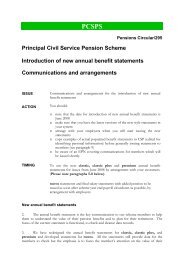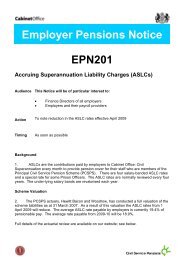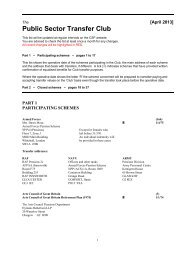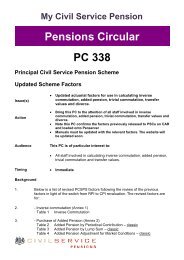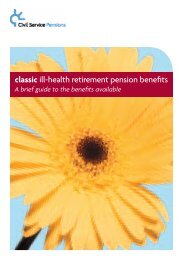Making Car Sharing and Car Clubs Work - Case ... - The Civil Service
Making Car Sharing and Car Clubs Work - Case ... - The Civil Service
Making Car Sharing and Car Clubs Work - Case ... - The Civil Service
You also want an ePaper? Increase the reach of your titles
YUMPU automatically turns print PDFs into web optimized ePapers that Google loves.
MAKING CAR SHARING AND CAR CLUBS WORKCASE STUDY SUMMARIES18.13 Usage levels for the Club are as follows:5 or more times per week 0 members2-4 times per week 4 membersOnce per week8 members1-3 times per month 8 membersLess than once a month9 members18.14 <strong>The</strong> Club’s founder members were more interested in the environmental aspects of thescheme, <strong>and</strong> helped to promote the Club, but this group tends not to use the cars verymuch. At least three of the initial members joined to support the club, but do not use the carsat all. Members who joined later, after the scheme was established, tend to have joined forpersonal financial reasons. For example, they are retired <strong>and</strong> their car is coming to the endof its life, they have had problems with parking locally, they have changed their work pattern<strong>and</strong> no longer need a car for commuting. Members who have joined for financial reasonstend to use the cars more frequently. Marketing now concentrates on the practical, personalbenefits of car club membership, with existing members talking about how they use the cars.It also stresses the no-hassle element of car club use.18.15 <strong>The</strong> patterns of usage vary. Some members use the Club’s vehicles for business purposessuch as visiting clients <strong>and</strong> delivering goods. Others use the Club for those journeys that aremore difficult to make by public transport, such as church attendance, evening social clubs,shopping <strong>and</strong> visiting relatives. Discussion with users about their travel choices show thatthe hierarchy of travel choice for these car club members is significantly different from carowners: Club members walk wherever possible, use public transport <strong>and</strong> only book a carclub car or a taxi for awkward journeys or when public transport is not available or suitable.Cycling was not mentioned, although it should be noted that Slaithwaite <strong>and</strong> Marsden are inthe Pennines.Successes <strong>and</strong> failures18.16 All of the members <strong>and</strong> the Coordinator feel that the Club has been a success. <strong>The</strong>ir majorconcern was the short-term funding arrangement to cover the scheme’s overheads <strong>and</strong>operating losses.18.17 One early problem was the location of the Zafira. It was parked in a part of Marsdenidentified by the feasibility study as a key area for people likely to be interested in a car club.Despite the car being well located, none of the prospective members materialised, so after afew months it was relocated to Slaithwaite. Slaithwaite members commented on theadvantage of having three types of vehicle available: being able to choose the right vehiclefor the journey is seen as a distinct advantage a car club has over car ownership.18.18 Another key issue was the lack of money for marketing the club. Marketing has always hadto be done on a shoestring, or time has to be spent finding additional financial or in-kindFinal V1.1, Dec. 2004 - 98 -




